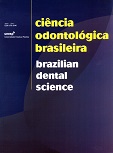Tempo de uso e a qualidade das próteses totais – uma análise crítica
DOI:
https://doi.org/10.14295/bds.2008.v11i2.471Abstract
O paciente desdentado total pode ser considerado mutilado, pois a perda dos dentes naturais causa uma deterioração das funções básicas do sistema estomatognático. Assim, este estudo verificou a influência do tempo de uso das atuaispróteses totais sobre sete fatores relacionados à qualidade das mesmas. Foram examinados 166 pacientes totalmente edêntulos usuários de próteses totais bi-maxilares, constituindo três grupos: A- tempo de uso menor ou igual a 5 anos; B- tempo de uso de 5 a 10 anos e C- tempo de uso maior que 10 anos. Para a avaliação da qualidade as mesmas foram classificadas em três categorias: boa, regular ou ruim. Aos sete fatores avaliados foram atribuídos escores dos quais a soma dos valores de conversão pôde variar de 0 (zero) até 100 (cem). Os dados obtidos foram submetidos ao teste de Qui-quadrado (X2). Dos pacientes avaliados, 112 eram mulheres e 54 homens, com idade média de 65,3 anos, 73 pacientes utilizavam as próteses totais por até 5 anos, 23 as utilizavam há mais de 5 anos e menos de 10 anos e 70 pacientes utilizavam as próteses há mais de 10 anos. Com relação à qualidade, 53 pacientes utilizavam próteses totais de boa qualidade, 54 pacientes, próteses regulares e 59 pacientes, próteses ruins, com diferença estatisticamente significante do tempo de uso sobre a qualidade geral das próteses (p= 1,862E-15). Concluiu-se que o tempo de uso influencia na qualidade geral das próteses totais.
Downloads
Downloads
Published
How to Cite
Issue
Section
License
Brazilian Dental Science uses the Creative Commons (CC-BY 4.0) license, thus preserving the integrity of articles in an open access environment. The journal allows the author to retain publishing rights without restrictions.
=================




























